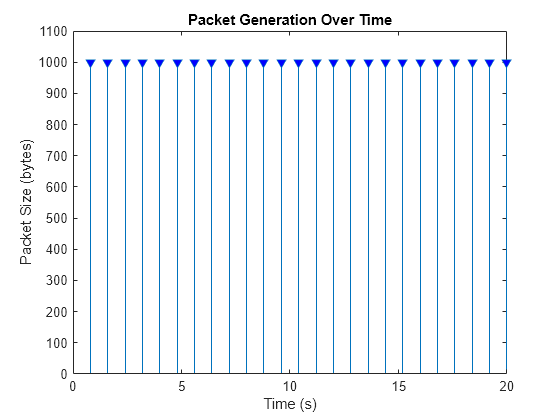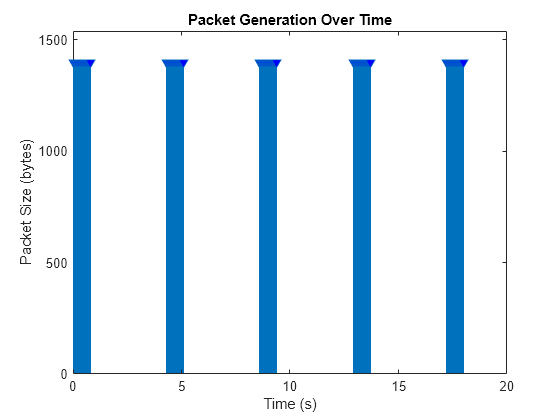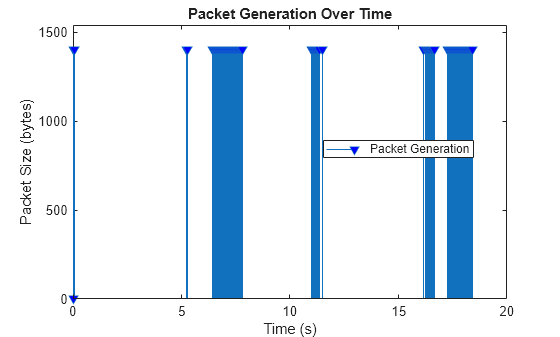Generate Periodic, Bursty, and Random Traffic in Wireless Network
This example demonstrates how to generate periodic, bursty, and random traffic patterns, for network performance analysis, by using the networkTrafficOnOff object of the Communications Toolbox™ Wireless Network Simulation Library.
Periodic Traffic
Periodic traffic involves transmitting data packets at regular intervals. Instances of periodic traffic include sensor networks reporting at fixed intervals, heartbeat messages in network protocols, and timed updates in control systems.
To simulate periodic traffic using the networkTrafficOnOff object, follow these steps:
Create a networkTrafficOnOff object with these properties.
On state duration —
InfPacket generation rate during On state — 10 kbps
Length of packet to be generated — 1000 bytes
Flag to indicate whether to generate application packet —
true
cfgPeriodic = networkTrafficOnOff(OnTime=Inf,DataRate=10, ... PacketSize=1000, ... GeneratePacket=true); % Configuration for periodic traffic
Set the simulation duration.
simulationDuration = 20; % SecondsInitialize the current simulation time.
currentTime = 0; % Current simulation timeCalculate the time to generate one packet. The time to generate one packet equals the packet size, in bits, divided by the data rate, in bits per second.
packetSizeBits = cfgPeriodic.PacketSize*8; % Convert packet size from bytes to bits dataRateSeconds = cfgPeriodic.DataRate*1000; % Convert data rate from kilobits/second to bits/second timePerPacket = packetSizeBits/dataRateSeconds; % Time to generate one packet in seconds
Estimate the number of packets to be generated.
numPackets = ceil(simulationDuration/timePerPacket);
Preallocate arrays for storing the packet times and sizes.
packetTimes = zeros(1,numPackets); packetSizes = zeros(1,numPackets);
Generate periodic traffic by using the generate object function of the networkTrafficOnOff object
packetCount = 0; % Generate Periodic Traffic while currentTime < simulationDuration % Generate packet and calculate next packet generation time [dt,packetSize] = generate(cfgPeriodic); currentTime = currentTime + dt/1000; % Convert ms to seconds for the next iteration packetCount = packetCount + 1; packetTimes(packetCount) = currentTime; packetSizes(packetCount) = packetSize; fprintf("Time: %f s - Generated a periodic packet of size %d bytes\n", currentTime, packetSize); end
Time: 0.800000 s - Generated a periodic packet of size 1000 bytes Time: 1.600000 s - Generated a periodic packet of size 1000 bytes Time: 2.400000 s - Generated a periodic packet of size 1000 bytes Time: 3.200000 s - Generated a periodic packet of size 1000 bytes Time: 4.000000 s - Generated a periodic packet of size 1000 bytes Time: 4.800000 s - Generated a periodic packet of size 1000 bytes Time: 5.600000 s - Generated a periodic packet of size 1000 bytes Time: 6.400000 s - Generated a periodic packet of size 1000 bytes Time: 7.200000 s - Generated a periodic packet of size 1000 bytes Time: 8.000000 s - Generated a periodic packet of size 1000 bytes Time: 8.800000 s - Generated a periodic packet of size 1000 bytes Time: 9.600000 s - Generated a periodic packet of size 1000 bytes Time: 10.400000 s - Generated a periodic packet of size 1000 bytes Time: 11.200000 s - Generated a periodic packet of size 1000 bytes Time: 12.000000 s - Generated a periodic packet of size 1000 bytes Time: 12.800000 s - Generated a periodic packet of size 1000 bytes Time: 13.600000 s - Generated a periodic packet of size 1000 bytes Time: 14.400000 s - Generated a periodic packet of size 1000 bytes Time: 15.200000 s - Generated a periodic packet of size 1000 bytes Time: 16.000000 s - Generated a periodic packet of size 1000 bytes Time: 16.800000 s - Generated a periodic packet of size 1000 bytes Time: 17.600000 s - Generated a periodic packet of size 1000 bytes Time: 18.400000 s - Generated a periodic packet of size 1000 bytes Time: 19.200000 s - Generated a periodic packet of size 1000 bytes Time: 20.000000 s - Generated a periodic packet of size 1000 bytes
Plot the packet generation times and sizes.
figure % Creates a new figure window stem(packetTimes, packetSizes,"filled", ... Marker="v",MarkerSize=6,MarkerFaceColor="b") xlabel("Time (s)") ylabel("Packet Size (bytes)") title("Packet Generation Over Time") xlim([0 simulationDuration]) ylim([0 max(packetSizes) * 1.1]) % Adjust Y-axis to clearly show packet sizes legend("Packet Generation", "Location", "Best")

The figure illustrates the packet generation over the 20-second simulation duration. Each vertical line (stem) represents a packet generation event, which occur at regular 0.800-second intervals, confirming the periodic nature of the traffic.
Bursty Traffic
Bursty traffic includes periods of high activity (bursts) followed by periods of low or no activity (silence). The application examples include, but are not limited to, video streaming and web browsing, where user actions or data generation occur in bursts followed by periods of inactivity.
To simulate bursty traffic using the the networkTrafficOnOff object, follow these steps:
Create a networkTrafficOnOff object with these properties. In this configuration, the On state duration is shorter than the Off state duration and set a high value for DataRate to simulate the bursty nature of the traffic during the On state. This reflects the sudden spikes in network activity common in bursty traffic patterns.
On state duration — 0.8 seconds
Off state duration — 3.5 seconds
Packet generation rate during On state — 1000 kbps
Length of packet to be generated — 1400 bytes
Flag to indicate whether to generate application packet —
true
cfgBursty = networkTrafficOnOff(OnTime=0.8,OffTime=3.5, ... DataRate=1e3,PacketSize=1400, ... GeneratePacket=true); % Configuration for Periodic Traffic
Set the simulation duration.
simulationDuration = 20; % secondsInitialize the current simulation time.
currentTime = 0; % Current simulation timeCalculate the time to generate one packet. The time to generate one packet equals the packet size in bits divided by the data rate in bits per second.
packetSizeBits = cfgBursty.PacketSize*8; % Convert packet size from bytes to bits dataRateSeconds = cfgBursty.DataRate*1000; % Convert data rate from kilobits/second to bits/second timePerPacket = packetSizeBits/dataRateSeconds; % Time to generate one packet in seconds
Estimate the number of packets to be generated.
numPackets = ceil(simulationDuration/timePerPacket);
Preallocate arrays for storing packet times and sizes.
packetTimes = zeros(1,numPackets); packetSizes = zeros(1,numPackets);
Generate bursty traffic by using the generate object function of the the networkTrafficOnOff object
packetCount = 0; % Generate Periodic Traffic while currentTime < simulationDuration % Generate packet and calculate next packet generation time [dt,packetSize] = generate(cfgBursty); currentTime = currentTime + dt/1000; % Convert ms to seconds for the next iteration packetCount = packetCount + 1; packetTimes(packetCount) = currentTime; packetSizes(packetCount) = packetSize; % Uncomment this line to view the packet generation instances and packet sizes. % fprintf("Time: %f s - Generated a periodic packet of size %d bytes\n", currentTime, packetSize); end
Plot the packet generation times and sizes.
figure % Creates a new figure window stem(packetTimes,packetSizes,"filled", ... Marker="v",MarkerSize=6,MarkerFaceColor="b") xlabel("Time (s)") ylabel("Packet Size (bytes)") title("Packet Generation Over Time") xlim([0 simulationDuration]) ylim([0 max(packetSizes) * 1.1]) % Adjust Y-axis to clearly show packet sizes legend("Packet Generation", "Location", "Best")

The figure illustrates the bursty traffic generation over the 20-second simulation duration. In the first on period, which lasts from 0 to 0.8 seconds, the generate function generates packets at regular intervals of 0.0112 seconds. This results in 71 packets, as the remaining 0.0048 seconds in the first on period is insufficient to generate an additional packet. To calculate the total number of packets generated during the On state, multiply the On state duration in seconds by the packet generation rate in kilobits per second, and then divide by 8 times the length of each packet in bytes. The On duration accommodates only whole packets, as the generate function does not support fractions. The networkTrafficOnOff object carries over any leftover data to the next On state, accounting for the remaining time from the previous On state.
During the OffTime period (3.5 seconds), the generate function generates no packets. This Off period spans from 0.8 seconds to 4.3 seconds. The second On period begins at 4.3 seconds. Due to the shortfall of 0.0064 seconds from the first On period, the generate function generates the first packet in the second On period at 4.3064 seconds. During this second On period, the generate function continues to generate packets at regular intervals of 0.0112 seconds, resulting in a total of 71 packets by the end of this period. This process continues for subsequent On and Off periods throughout the simulation.
Random Traffic
Random traffic involves data packets being transmitted at unpredictable intervals. To simulate this behavior, you can use the networkTrafficOnOff object, which generates a random traffic pattern by using exponential distributions to determine the durations of the On and Off states. This approach introduces randomness into the traffic, as the time spent in each state fluctuates based on the exponential distribution.
To simulate random traffic using the the networkTrafficOnOff object, follow these steps:
Create a networkTrafficOnOff object with these properties.
Exponential distribution mean value for the On state duration — 0.6 seconds
Exponential distribution mean value for the Off state duration — 2.5 seconds
Packet generation rate during On state — 1000 kbps
Length of packet to be generated — 1400 bytes
Flag to indicate whether to generate application packet —
true
cfgRandom = networkTrafficOnOff(OnExponentialMean=0.6, ... OffExponentialMean=2.5,DataRate=1e3,PacketSize=1400, ... GeneratePacket=true); % Configuration for random Traffic
Set the simulation duration.
simulationDuration = 20; % secondsInitialize the current simulation time.
currentTime = 0; % Current simulation timeCalculate the time to generate one packet. The time to generate one packet equals the packet size in bits divided by the data rate in bits per second.
packetSizeBits = cfgRandom.PacketSize*8; % Convert packet size from bytes to bits dataRateSeconds = cfgRandom.DataRate*1000; % Convert data rate from kilobits/second to bits/second timePerPacket = packetSizeBits/dataRateSeconds; % Time to generate one packet in seconds
Estimate the number of packets to be generated.
numPackets = ceil(simulationDuration/timePerPacket);
Preallocate arrays for storing packet times and sizes.
packetTimes = zeros(1,numPackets); packetSizes = zeros(1,numPackets);
Generate random traffic by using the generate object function of the the networkTrafficOnOff object
packetCount = 0; % Generate Periodic Traffic while currentTime < simulationDuration % Generate packet and calculate next packet generation time [dt,packetSize] = generate(cfgRandom); currentTime = currentTime + dt/1000; % Convert ms to seconds for the next iteration packetCount = packetCount + 1; packetTimes(packetCount) = currentTime; packetSizes(packetCount) = packetSize; end
Plot the packet generation times and sizes.
figure % Creates a new figure window stem(packetTimes,packetSizes,"filled", ... Marker="v",MarkerSize=6,MarkerFaceColor="b") xlabel("Time (s)") ylabel("Packet Size (bytes)") title("Packet Generation Over Time") xlim([0 simulationDuration]) ylim([0 max(packetSizes) * 1.1]) % Adjust Y-axis to clearly show packet sizes legend("Packet Generation", "Location", "Best")

From this figure, you can observe that the on time and off time states vary randomly according to the exponential distribution.
Copyright 2024–2025 The MathWorks, Inc.
See Also
Topics
- Create, Configure and Simulate Bluetooth Mesh Network (Bluetooth Toolbox)
- Create, Configure, and Simulate an 802.11ax Mesh Network (WLAN Toolbox)